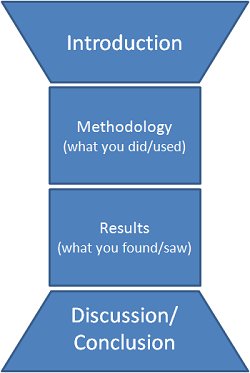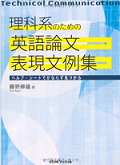Introductionの構造
Introductionの構造について
論文の最初に来るのがこの"Introduction"なので、この章では、読者があなたの論文にすんなりと入っていけるように、上手く導いてあげなければなりません。一方、最後の"Discussion/Conclusion"では、すんなりと読み終われるような締めの章にしなければなりません。

上の図は、Introductionとその他の章との関係を簡単に表したものです。Introductionの始まりは、一般的な内容からスタートし、論文の中心のMethodology/Resultsの内容にに焦点を絞っていくように議論を狭めていきます。説明が抽象的になっているので、次の例文を一緒に読みながら、今言った内容を理解していきましょう。(ここでは、構造を学ぶだけなので、例文のテーマや専門的過ぎる単語はあまり気にしないでください。
The synthesis of flexible polymer blends from polylactide and rubber
((Introduction))
(1) Polylactide (PLA) has received much attention in recent years due to its biodegradable properties, which offer important economic benefits. (2) PLA is a polymer obtained from corn and is produced by the polymerization of lactide. (3) It has many possible uses in the biomedical field[1] and has also been investigated as a potential enginnering material.[2,3] (4) However, it has been found to be too weak under impact to be used commercially.[4]
(5) One way to toughen polymers is to incorporate a layer of rubber particles[5] and there has been extensive research regarding the rubber modification of PLA. (6) For example, Penney et al. showed that PLA composites could be prepared using blending techniques[6] and more recently, Hiller established the toughness of such composites.[7] (7) However, although the effect of the rubber particles on the mechanical properties of copolymer systems was demonstrated over two years ago,[8] little attention has been paid to the selection of an appropriate rubber component.
(8) The present paper presents a set of criteria for selecting such a component. (9) On the basis of these criteria it then describes the preparation of a set of polymer blends using PLA and a hydrocarbon rubber (PI). (10) This combination of two mechanistically distinct polymerizations formed a novel copolymer in which the incorporation of PI significantly increased flexibility.
この論文のIntroductionを見ると、とてもありきたりなものに思えるかもしれません。しかし、英語がネイティブではない研究者は、まずこのレベルの英語が書けなければなりません。最初の段落(1)-(4)は、一言で言うとポリ乳酸についてです。個別に見ていくと、
- (1) ポリ乳酸は大切!
- (2) ポリ乳酸はどのようなものか?
- (3) ポリ乳酸のすごさをアピール
- (4) ポリ乳酸の問題点
上の図に示したように、Introductionの入りは、一般的、幅広い内容となります。皆さんがそれぞれの論文を書く際には、ポリ乳酸のところを自分の研究物質、新しい自分なりの研究手法、理論などに置き換えて書き変えてみてください。初めはこの4つのポイントを、それぞれ1文章ずつ書いていけばよいでしょう。少し英語論文を書くのに慣れてくれば、上の流れに沿って、自分なりの肉付けをしてボリュームを増やしていってみてください。
そして、次の段落では、少し内容が専門的に、つまり狭まっていきます。最初の段落で、研究対象であるポリ乳酸の問題点を提起しました。そして、この提起を受けて、以下のように展開していきます。
- (5) ポリ乳酸の問題点を解決する可能性
- (6) これまでの問題点解決のための研究例紹介
- (7) これまでの研究例では不十分である!
この段落では、文章量は自分で調節しながら上手く説明をしてください。問題点を解決する可能性がある方法が複数ある場合は、(5)と(6)にあたる部分がもっと分量が増えてきます。
最後の段落では、さらに自分の研究内容に焦点を絞って、
- (8) この自分の論文について一言で言うと
- (9) 自分の研究の結果
- (10) 自分の研究結果から、新しく提供できること(新しい点、問題解決点)
この段落では、メインのMethodology/Resultsに読者の気持ちが集中できるように、自分の研究についてのみ述べて終了となります。
Sponsored link

藤野 輝雄 (著)
理系の英語論文での使用頻度が高く、有用な表現を工学、医学、化学など幅広い分野から集めた、研究者が完成度の高い論文を仕上げるために必須な参考書です。ヘルプ・シート、詳細な目次、索引により、必要とする表現が容易に探し出せるようになっています。